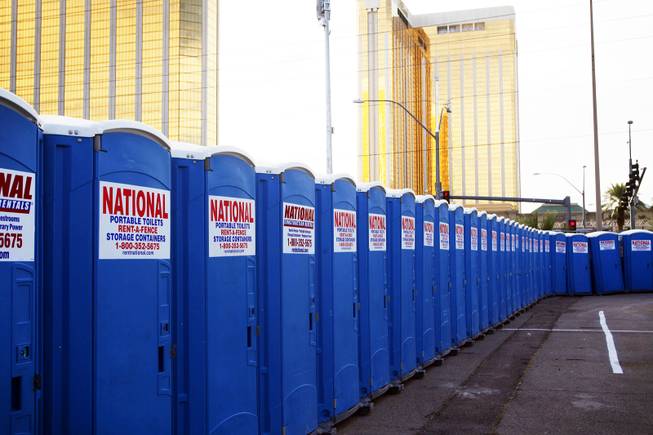
Portable toilets are ready to go during setup for the 48 Hours Festival across Las Vegas Boulevard from the Luxor in Las Vegas Friday, Oct. 14, 2011.
Thursday, June 26, 2014 | 2 a.m.
Headed to the bathroom? If you think you might have to "pee like a race horse," join the club — so does everyone else. Scientists who watched dozens of different mammals from rats to elephants relieve themselves found that most of them seem to urinate in the same time frame — around 21 seconds.
The findings, released by the Proceedings of the National Academy of Sciences, shed light on the mysterious fluid dynamics of urination and could help engineers build better flow-regulating devices.
David Hu, a mechanical engineer at the Georgia Institute of Technology and the study's co-author, has two young children and said he got the idea for the experiment while changing diapers a couple years back.
"I was thinking, 'How could anything be worse right now?'" Hu said. "And I thought, 'Well, maybe if I was changing an elephant's diaper it would really bad.'"
The researchers headed over to Zoo Atlanta to watch the animals do their business. Hu has done some unconventional experiments with fire ants, but watching animals relieve themselves came with its own unique challenges.
While timing each pee session was easy, measuring the flow rate was hard, because they had to collect the urine. That's no easy task. First off, it's hard to catch an animal in the act. Second, you have to catch all the urine in order to get an accurate measurement of how much liquid is coming out per second. And you have to do it by hand. It was unavoidable: The high-speed camera was occasionally splattered by urine, Hu said.
Figuring out how to collect the urine at all was a conundrum in itself, Hu said.
"We ended up cutting sections of soda bottles, because it has to be something you can hold by hand, and just at a second's notice go on your hands and knees and hold it in the right position," Hu said. "Everything else we tried failed. We tried pans — they don't like pans, they think it's weird. We tried pads — they don't like pads, they think it's weird."
The researchers also looked at YouTube videos of animals peeing and combed the literature to compare the sizes of each species' bladder and the length and width of the urethra, the tube that allows urine to leave the body.
Tiny animals, like rats, appeared to urinate in a very different way from us — in little "gumballs" of water dispensed one by one, Hu said. Small animals don't have enough liquid in their system to make it flow. But animals bigger than 6.6 pounds (including humans) can store a large amount of urine and used essentially the same mechanism — it basically came out in a jet or a stream.
While some of those larger animals had really capacious bladders (an elephant can fill a kitchen garbage can with pee), they all, from the cat to the goat to the elephant, seem to empty in about the same time: 21 seconds, give or take 13 seconds. That range may partly be because the animals often urinate for different reasons — males often use urine to mark territory, for example, and some rodents use the urine as a defense.
Still, Hu says it's a remarkably tight window. After all, even though an elephant's 18-liter bladder is nearly 3,600 times larger than a cat's, it doesn't take 3,600 times longer to empty. This means that the elephant must be spewing out a massive torrent of liquid at high speeds in order to empty itself in the same time frame as a relatively tiny feline bladder.
The secret seems to lie in the urethra's design, which uses gravity to its advantage. The longer the urethra, the faster the flow — because just as the pressure builds toward the bottom of a deep swimming pool, the pressure in a liquid-filled urethra also builds toward the bottom of the tube. And since the urethra is also proportionally wider in larger animals, it basically adds extra lanes to this fast-moving pee freeway — or "pee-way," if you will.
Understanding urination duration has important health implications, Hu said, given that illnesses like prostate cancer or conditions like obesity can put pressure on the urethra, making the process of voiding lengthier. If it takes too long to pee, chances are there's a health problem that needs attention.
It also clarifies which animals are the most accurate models to help understand human urination in the laboratory — and it probably isn't rats.
Understanding the urinary tract, a mechanism that works at many different size scales, could also help engineers build better devices that rely on fluid flow, from above-ground water tanks to water-efficient toilets.

Join the Discussion:
Check this out for a full explanation of our conversion to the LiveFyre commenting system and instructions on how to sign up for an account.
Full comments policy